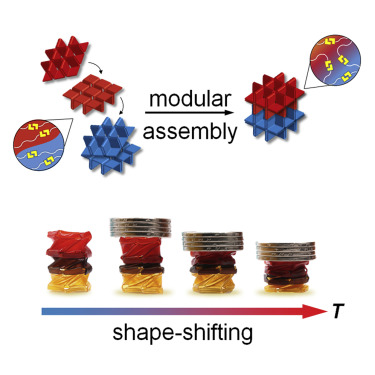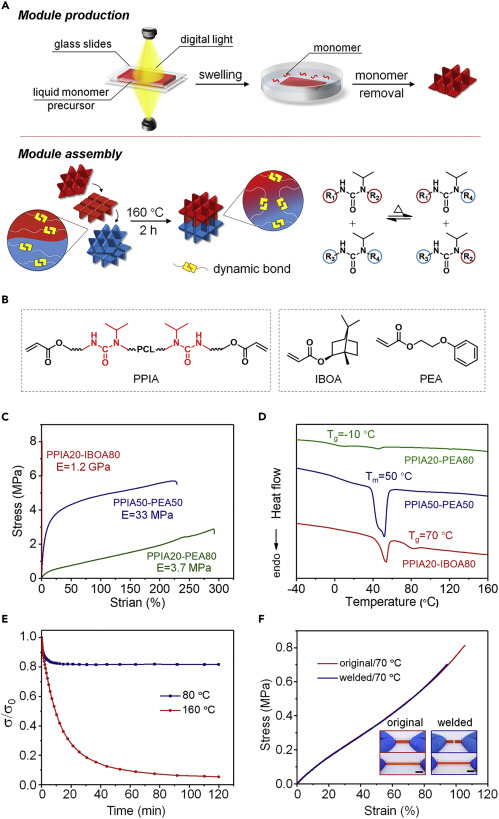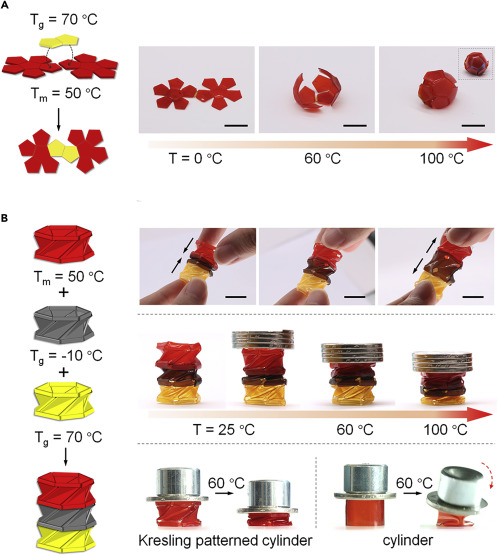Researchers in China have presented a study on a modular method of 4D printing that aims to overcome the geometrical limitations of the process.
The advantage of 4D printing, based on a digitally controlled 2D-to-3D transformation, is that it forgoes the layer-by-layer fabrication process of 3D printing, resulting in a faster production method. However, the accessible shapes that can be produced via 4D printing are limited.
As such, the authors of the study have created a modular 4D printing system developed via interfacial welding of digital light-controllable modules. The properties of these 3D printable modules are distinctively different, and can be tailored and assembled together. The researchers write that their modular 4D printing system overcomes the aforementioned limitations of the technology: “This method allows access to geometrically complex and functionally diverse shape-shifting devices while maintaining the speed advantage of the 2D-to-3D transformation.”
“The versatility of our approach allows an extension to 3D devices with multi-functionalities beyond shape shifting.”

The advantages and limitations of 4D printing
The researchers explain that advanced multifunctional devices are highly pursued for their high value-added applications. However, these devices increasingly rely on the use of complex shapes for their functions, which traditional processing techniques fail to produce.
Although 3D printing enables the creation of complex shapes, it is limited by its fabrication speed and material diversity. The authors state that, although methods like grayscale DLP allows the production of multiple materials at a relatively high speed, the approach is tied to very specific chemistry and cannot be readily expanded to a diverse set of materials.
Alternatively, 4D printing based on digitally controlled 2D-to-3D transformation is fast but restricted in its ability to create complex shapes, and additionally the incorporation of drastically different multiple materials is difficult. Noting that this process is different from 4D printing where 3D printed objects undergo shape shifting with time, digitally controlled 2D-to-3D transformation forgoes the layer printing process altogether, which is where its advantage in speed comes from.
The process is geometrically restricted as it relies on the 2D-to-3D transformation of a single-layer film, limiting the range of accessible 3D shapes. As such, the researchers report a concept that aims to extend the single-layer 3D transformation into multi-layer 3D transformation by combining 4D printing with modular assembly. This enables the possibility of fabricating geometrically complex shape-memory devices with sophisticated functions.
“Complex 3D objects with tailorable multiple materials can consequently be produced. This allows the fabrication of sophisticated shape-memory devices including a 3D Miura-patterned structure with zero Poisson’s ratio and a Kresling-patterned cylindrical structure with superior mechanical stability. Our approach extends the possibilities for the future development of multifunctional devices with seamless integration of material, structure, and function,” write the authors.

The modular 4D printing structure
The researchers’ modular 4D printing system uses a double-sided digital light which is projected onto a printing precursor consisting of photocurable monomers. These monomers contain dynamic covalent bonds, a photoinitiator, a light absorber, and a solvent (toluene). When exposed to light, the solution is cured and its light attenuation enhanced, thus establishing a curing gradient in the out-of-plane dimension. When the uncured monomers and solvent are removed from the cured film, it develops the 2D film into 3D due to the material heterogeneity in the out-of-plane dimension. “Following this process, independent variations in the printing precursors can result in 3D objects with tailorable materials properties, which we call 3D material modules,” explain the researchers.
Each of the modules feature shapes that can be separately manipulated and connected via interfacial welding through dynamic covalent bond exchange. To demonstrate the principle, the authors employed a set of monomers/crosslinkers, with variations in the mixing ratio between PPIA, PEA, and IBOA causing different types of material modules. These modules were denoted as PPIA20-IBOA80, PPIA50-PEA50, and PPIA20-PEA80. The denotations correspond to the monomers used and their weight percentages in the formulation.

Presenting one example, the authors write: “Two 4D-printed samples of PPIA20-IBOA80 (Tg = 70°C) and PPIA50-PEA50 (Tm = 50°C) are assembled together by locally applying a small force onto the non-hinged area during welding. By the mechanism of shape memory, the sample is deformed into a flat sheet at 100°C and fixed by cooling to 0°C. Upon reheating, the resulting multi-material assembly can undergo sequential folding to yield a ball owing to the spatially distinct thermal transitions.”
Concluding the paper, the researchers explain that the modular structure not only carries the advantages of 4D printing, but also enables the manipulation of the printed shapes and the integration of multiple distinct materials through the interfacial bond exchange between material modules. They write that “these features allow versatile integration of materials and structures, leading to unusual opportunities to construct multi-responsive devices with geometry-dictated functions. Overall, the concept of modular 4D printing expands the technological scope for structurally complex and functionally diverse morphing devices.”

4D printing research
The process of a 3D printed object changing its shape over time has commonly been referred to as 4D printing. The field of 4D printing has seen a number of developments recently, as researchers around the world leverage its unique capabilities in a variety of applications and fields in order to develop the process. For example, last month, a collaborative research project between Singapore University of Technology and Design (SUTD) and Nanyang Technological University (NTU) resulted in a 3D printed material changing its shape and back again numerous times without any electrical input.
In February, researchers from Rutgers University, New Jersey, created 4D printed bioinspired, programmable microneedles that enhanced tissue adhesion using Projection micro-stereolithography (PµSL). 4D printed backward-facing barbs were fabricated and designed to deform horizontally to be minimally invasive upon tissue contact.
And in late 2019, Harvard University researchers produced a study that sought to overcome the challenges to 4D printing, mainly the ability to create complex, smoothly-curved shapes. They were able to create a frequency-shifting antenna, and a flat lattice that, when placed in salt water, takes on the shape of a human face.
The research paper discussed in this article, ‘Modular 4D Printing via Interfacial Welding of Digital Light-Controllable Dynamic Covalent Polymer Networks’, is published in the journal Matter. It is written by Zizheng Fang, Huijie Song, Yue Zhang, Binjie Jin, Jingjun Wu, Qian Zhao and Tao Xie of .
The nominations for the 2020 3D Printing Industry Awards are now open. Who do you think should make the shortlists for this year’s show? Have your say now.
Subscribe to the 3D Printing Industry newsletter for the latest news in additive manufacturing. You can also stay connected by following us on Twitter and liking us on Facebook.
Looking for a career in additive manufacturing? Visit 3D Printing Jobs for a selection of roles in the industry.

